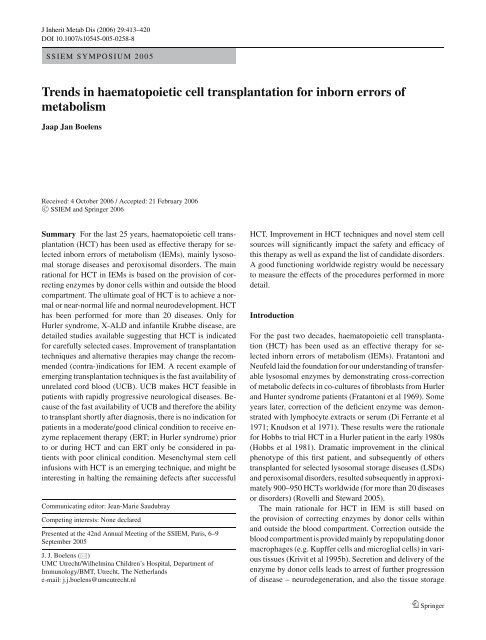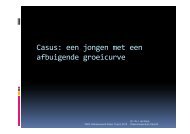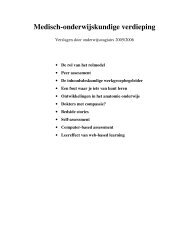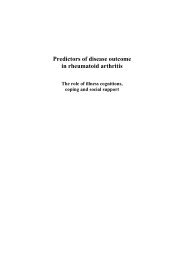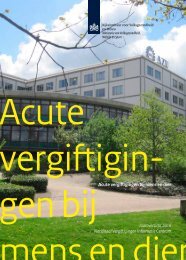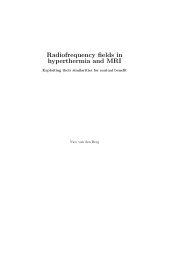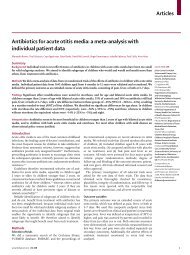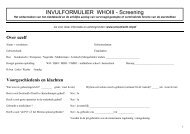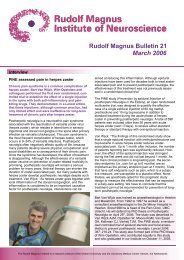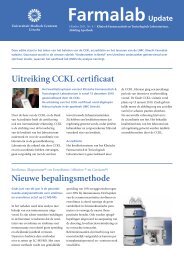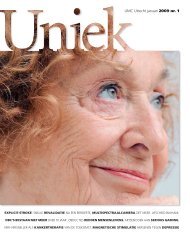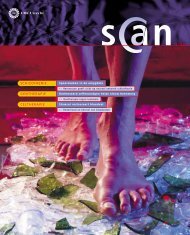Trends in haematopoietic cell transplantation for ... - UMC Utrecht
Trends in haematopoietic cell transplantation for ... - UMC Utrecht
Trends in haematopoietic cell transplantation for ... - UMC Utrecht
Create successful ePaper yourself
Turn your PDF publications into a flip-book with our unique Google optimized e-Paper software.
J Inherit Metab Dis (2006) 29:413–420<br />
DOI 10.1007/s10545-005-0258-8<br />
SSIEM SYMPOSIUM 2005<br />
<strong>Trends</strong> <strong>in</strong> <strong>haematopoietic</strong> <strong>cell</strong> <strong>transplantation</strong> <strong>for</strong> <strong>in</strong>born errors of<br />
metabolism<br />
Jaap Jan Boelens<br />
Received: 4 October 2006 / Accepted: 21 February 2006<br />
C○ SSIEM and Spr<strong>in</strong>ger 2006<br />
Summary For the last 25 years, <strong>haematopoietic</strong> <strong>cell</strong> <strong>transplantation</strong><br />
(HCT) has been used as effective therapy <strong>for</strong> selected<br />
<strong>in</strong>born errors of metabolism (IEMs), ma<strong>in</strong>ly lysosomal<br />
storage diseases and peroxisomal disorders. The ma<strong>in</strong><br />
rational <strong>for</strong> HCT <strong>in</strong> IEMs is based on the provision of correct<strong>in</strong>g<br />
enzymes by donor <strong>cell</strong>s with<strong>in</strong> and outside the blood<br />
compartment. The ultimate goal of HCT is to achieve a normal<br />
or near-normal life and normal neurodevelopment. HCT<br />
has been per<strong>for</strong>med <strong>for</strong> more than 20 diseases. Only <strong>for</strong><br />
Hurler syndrome, X-ALD and <strong>in</strong>fantile Krabbe disease, are<br />
detailed studies available suggest<strong>in</strong>g that HCT is <strong>in</strong>dicated<br />
<strong>for</strong> carefully selected cases. Improvement of <strong>transplantation</strong><br />
techniques and alternative therapies may change the recommended<br />
(contra-)<strong>in</strong>dications <strong>for</strong> IEM. A recent example of<br />
emerg<strong>in</strong>g <strong>transplantation</strong> techniques is the fast availability of<br />
unrelated cord blood (UCB). UCB makes HCT feasible <strong>in</strong><br />
patients with rapidly progressive neurological diseases. Because<br />
of the fast availability of UCB and there<strong>for</strong>e the ability<br />
to transplant shortly after diagnosis, there is no <strong>in</strong>dication <strong>for</strong><br />
patients <strong>in</strong> a moderate/good cl<strong>in</strong>ical condition to receive enzyme<br />
replacement therapy (ERT; <strong>in</strong> Hurler syndrome) prior<br />
to or dur<strong>in</strong>g HCT and can ERT only be considered <strong>in</strong> patients<br />
with poor cl<strong>in</strong>ical condition. Mesenchymal stem <strong>cell</strong><br />
<strong>in</strong>fusions with HCT is an emerg<strong>in</strong>g technique, and might be<br />
<strong>in</strong>terest<strong>in</strong>g <strong>in</strong> halt<strong>in</strong>g the rema<strong>in</strong><strong>in</strong>g defects after successful<br />
Communicat<strong>in</strong>g editor: Jean-Marie Saudubray<br />
Compet<strong>in</strong>g <strong>in</strong>terests: None declared<br />
Presented at the 42nd Annual Meet<strong>in</strong>g of the SSIEM, Paris, 6–9<br />
September 2005<br />
J. J. Boelens ()<br />
<strong>UMC</strong> <strong>Utrecht</strong>/Wilhelm<strong>in</strong>a Children’s Hospital, Department of<br />
Immunology/BMT, <strong>Utrecht</strong>, The Netherlands<br />
e-mail: j.j.boelens@umcutrecht.nl<br />
HCT. Improvement <strong>in</strong> HCT techniques and novel stem <strong>cell</strong><br />
sources will significantly impact the safety and efficacy of<br />
this therapy as well as expand the list of candidate disorders.<br />
A good function<strong>in</strong>g worldwide registry would be necessary<br />
to measure the effects of the procedures per<strong>for</strong>med <strong>in</strong> more<br />
detail.<br />
Introduction<br />
For the past two decades, <strong>haematopoietic</strong> <strong>cell</strong> <strong>transplantation</strong><br />
(HCT) has been used as an effective therapy <strong>for</strong> selected<br />
<strong>in</strong>born errors of metabolism (IEMs). Fratantoni and<br />
Neufeld laid the foundation <strong>for</strong> our understand<strong>in</strong>g of transferable<br />
lysosomal enzymes by demonstrat<strong>in</strong>g cross-correction<br />
of metabolic defects <strong>in</strong> co-cultures of fibroblasts from Hurler<br />
and Hunter syndrome patients (Fratantoni et al 1969). Some<br />
years later, correction of the deficient enzyme was demonstrated<br />
with lymphocyte extracts or serum (Di Ferrante et al<br />
1971; Knudson et al 1971). These results were the rationale<br />
<strong>for</strong> Hobbs to trial HCT <strong>in</strong> a Hurler patient <strong>in</strong> the early 1980s<br />
(Hobbs et al 1981). Dramatic improvement <strong>in</strong> the cl<strong>in</strong>ical<br />
phenotype of this first patient, and subsequently of others<br />
transplanted <strong>for</strong> selected lysosomal storage diseases (LSDs)<br />
and peroxisomal disorders, resulted subsequently <strong>in</strong> approximately<br />
900–950 HCTs worldwide (<strong>for</strong> more than 20 diseases<br />
or disorders) (Rovelli and Steward 2005).<br />
The ma<strong>in</strong> rationale <strong>for</strong> HCT <strong>in</strong> IEM is still based on<br />
the provision of correct<strong>in</strong>g enzymes by donor <strong>cell</strong>s with<strong>in</strong><br />
and outside the blood compartment. Correction outside the<br />
blood compartment is provided ma<strong>in</strong>ly by repopulat<strong>in</strong>g donor<br />
macrophages (e.g. Kupffer <strong>cell</strong>s and microglial <strong>cell</strong>s) <strong>in</strong> various<br />
tissues (Krivit et al 1995b). Secretion and delivery of the<br />
enzyme by donor <strong>cell</strong>s leads to arrest of further progression<br />
of disease – neurodegeneration, and also the tissue storage<br />
Spr<strong>in</strong>ger
414 J Inherit Metab Dis (2006) 29:413–420<br />
described, these be<strong>in</strong>g the diseases with the best detailed<br />
studies. In addition, new trends <strong>in</strong> HCT will be discussed<br />
<strong>for</strong> IEMs: (1) unrelated cord blood as an emerg<strong>in</strong>g stem<br />
<strong>cell</strong> source, (2) enzyme replacement therapy (ERT) <strong>in</strong><br />
comb<strong>in</strong>ation with HCT and (3) mesenchymal stem <strong>cell</strong><br />
<strong>transplantation</strong>.<br />
Outcome/effect of HCT <strong>in</strong> IEMs<br />
Fig. 1 Estimated frequencies of HCT <strong>for</strong> the various IEMs s<strong>in</strong>ce<br />
1980 worldwide. ∗ Other leukodystrophies/white-matter diseases (e.g.<br />
Pelizaeus–Merzbacher, Zellweger syndrome, vanish<strong>in</strong>g white-matter<br />
disease)<br />
(e.g. liver, heart, lungs) lead<strong>in</strong>g to dysfunction and <strong>in</strong>terfer<strong>in</strong>g<br />
with normal daily life. The ultimate goal of HCT is to<br />
achieve a normal or near-normal life and normal neurodevelopment.<br />
However, the exact mechanisms <strong>for</strong> therapeutic<br />
benefit of HCT are not completely understood and may differ<br />
between the various diseases. For <strong>in</strong>stance, <strong>in</strong> X-l<strong>in</strong>ked<br />
adrenoleukodystrophy (X-ALD) the mechanism may be related<br />
to halt<strong>in</strong>g the central nervous system (CNS) <strong>in</strong>flammatory<br />
process associated with myel<strong>in</strong> <strong>in</strong>jury.<br />
The great majority of the transplants have been per<strong>for</strong>med<br />
<strong>for</strong> patients with Hurler syndrome, followed by<br />
other mucopolysaccharidoses (MPSs) (e.g. Hunter syndrome,<br />
Sanfilippo syndrome, Maroteaux–Lamy syndrome),<br />
X-l<strong>in</strong>ked adrenoleukodystrophy, metachromatic leukodystrophy,<br />
globoid-<strong>cell</strong> leukodystrophy (<strong>in</strong>clud<strong>in</strong>g Krabbe disease)<br />
and various mis<strong>cell</strong>aneous disorders(Fig. 1). Un<strong>for</strong>tunately,<br />
<strong>for</strong> unknown reasons, not all LSDs benefit from HCT;<br />
careful evaluation of the effect of HCT is there<strong>for</strong>e important<br />
to establish clear guidel<strong>in</strong>es <strong>for</strong> <strong>in</strong>dications <strong>for</strong> HCT (Peters<br />
and Steward 2003). On the basis of all available literature,<br />
consist<strong>in</strong>g mostly of retrospective studies, case reports and<br />
personal communications, Peters and Steward published a<br />
practical guidel<strong>in</strong>e outl<strong>in</strong><strong>in</strong>g recommended current <strong>in</strong>dications<br />
and contra<strong>in</strong>dications (Peters and Steward 2003). However,<br />
evaluation of the true-long term effects of HCT is difficult<br />
<strong>for</strong> various reasons: (1) There is a wide spectrum of<br />
phenotype and disease stage be<strong>for</strong>e HCT. (2) Benefit varies<br />
between organs: reticuloendothelial organs such as liver and<br />
spleen often benefit more and faster than the CNS, <strong>in</strong> case<br />
of the latter probably because of the slower turnover of microglia<br />
and their replacement by donor <strong>cell</strong>s. In addition,<br />
little impact of HCT on bone defects has been described. (3)<br />
Transplantation related morbidity (GvHD, viral <strong>in</strong>fections)<br />
and mixed chimerism (and graft failure) can <strong>in</strong>fluence the<br />
outcome. (4) The absence of a good function<strong>in</strong>g (worldwide)<br />
registry is a h<strong>in</strong>drance.<br />
In this m<strong>in</strong>i-review the outcome/effect of HCT on Hurler<br />
syndrome, X-ALD and <strong>in</strong>fantile Krabbe disease will be<br />
Hurler syndrome<br />
The number of Hurler patients who have undergone HCT is<br />
estimated to be more than 400, and the results <strong>for</strong> Hurler syndrome<br />
are the most extensively studied (Boelens et al 2005a;<br />
Kurtzberg and Krivit 2004; Peters et al 1996, 1998a; Souillet<br />
et al 2003; Staba et al 2004). Donor engraftment after HCT<br />
<strong>in</strong> Hurler patients leads to a rapid reduction of obstructive airway<br />
symptoms, hepatosplenomegaly and corneal cloud<strong>in</strong>g.<br />
Hydrocephalus is either prevented or stabilized and hear<strong>in</strong>g<br />
impairment improves <strong>in</strong> many children (Boelens et al 2005a;<br />
Peters et al 1996; Peters et al 1998a, b; Souillet et al 2003;<br />
Staba et al 2004). In addition, successful HCT averts death<br />
from cardiac dysfunction (Braunl<strong>in</strong> et al 2001; V<strong>in</strong>allonga<br />
et al 1992), improves growth (near to normal growth velocity)<br />
and psychomotor development, and prolongs survival<br />
(Krivit et al 1995a; Peters et al 1996; Peters et al 1998a,<br />
b; Shapiro et al 1995; Souillet et al 2003; Staba et al 2004;<br />
Summers et al 1989). The rema<strong>in</strong><strong>in</strong>g problems after successful<br />
HCT are ma<strong>in</strong>ly orthopaedic problems (odontoid dysplasia,<br />
thoracolumbal gibbus, carpal tunnel syndrome), <strong>for</strong><br />
which additional <strong>in</strong>terventions are sometimes needed (Krivit<br />
et al 1995a; Souillet et al 2003; Staba et al 2004). In comparison,<br />
untreated Hurler syndrome children have severe<br />
growth failure by the age of 2 years, achiev<strong>in</strong>g a maximal<br />
height of 110 cm (<strong>in</strong> case of longer survival) (Neufeld and<br />
Muenzer 2001), and might have more orthopaedic <strong>in</strong>terventions.<br />
Longer follow-up is needed <strong>for</strong> evaluation of the effect<br />
of successful HCT on skeletal manifestations. Untreated patients<br />
die young severely retarded, by the median age of 7<br />
(range 1–15years). In addition to the results from studies<br />
cited above, a European retrospective study was per<strong>for</strong>med<br />
recently on behalf of the EBMT (European Blood and Marrow<br />
Transplantation) work<strong>in</strong>g committee. Factors <strong>in</strong>fluenc<strong>in</strong>g<br />
the engraftment and long-term follow-up were analysed<br />
(Boelens et al 2005a) <strong>in</strong> 146 patients transplanted <strong>for</strong> Hurler<br />
syndrome between 1994 and 2004, this be<strong>in</strong>g the largest number<br />
of case histories reported so far. Patients, extracted from<br />
the EBMT database, were analysed on the basis of completed<br />
questionnaires (<strong>transplantation</strong>-associated questions as well<br />
as some long-term follow-up data). Sixty-two patients were<br />
more than 36 months post HCT with a function<strong>in</strong>g graft. The<br />
acquired data (Table 1) confirm the data published earlier<br />
Spr<strong>in</strong>ger
J Inherit Metab Dis (2006) 29:413–420 415<br />
Table 1 Long-term follow-up<br />
of 62 Hurler patients more than<br />
36 months post HCT<br />
Miss<strong>in</strong>g<br />
Lansky score 4 Median 90 (70–100)<br />
Thoracolumbal gibbus 15 Progressive <strong>in</strong> 15%<br />
Length 15 Median SDS − 1 (23% < SDS − 2)<br />
Mental development 20 70% DQ/IQ > 90%<br />
Airway obstruction 2 Improved > 95%<br />
<strong>in</strong> smaller series: high Lansky scores (a rough parameter<br />
<strong>for</strong> play activity: scale ranges from 10 (moribund) to 100<br />
(normal activity); Lansky et al 1987), dramatic improvement<br />
of the airway obstructions, and normal mental development.<br />
A study analys<strong>in</strong>g all ‘alive and engrafted’ patients <strong>in</strong> the<br />
European series us<strong>in</strong>g the same tests per<strong>for</strong>med by the same<br />
‘specially tra<strong>in</strong>ed’ doctors would be the most precise way to<br />
analyse the long-term outcome <strong>in</strong> this historical group. Of<br />
course, prospective studies evaluat<strong>in</strong>g the outcome of HCT<br />
<strong>for</strong> IEMs are the most valuable.<br />
After the impressive results of HCT <strong>in</strong> Hurler syndrome<br />
(Hobbs et al 1981), it was expected that all MPS disorders<br />
could be alleviated by HCT. Un<strong>for</strong>tunately, of the other MPS<br />
disorders, benefit from HCT appears to be significant only<br />
<strong>for</strong> MPS VI (Maroteaux–Lamy) (Krivit et al 1984) and MPS<br />
VII (Sly) (Yamada et al 1998). It is unclear whether it will<br />
rema<strong>in</strong> an <strong>in</strong>dication <strong>for</strong> MPS VI if and when ERT becomes<br />
available.<br />
Krabbe disease and globoid-<strong>cell</strong> leukodystrophy<br />
In globoid-<strong>cell</strong> leukodystrophy (GLD), a disease characterized<br />
by periventricular demyel<strong>in</strong>ation, result<strong>in</strong>g <strong>in</strong> overwhelm<strong>in</strong>g<br />
spasticity and mental retardation/deterioration,<br />
two major phenotypes can be dist<strong>in</strong>guished: (1) an earlyonset<br />
<strong>for</strong>m also known as Krabbe disease and (2) late-onset<br />
disease (juvenile and adult <strong>for</strong>ms) (Wenger et al 2001). For<br />
the late-onset <strong>for</strong>ms it was demonstrated that, with appropriate<br />
tim<strong>in</strong>g of HCT, disease progression can be aborted (Krivit<br />
et al 1998). It was demonstrated also <strong>for</strong> the early-onset <strong>for</strong>m<br />
that disease progress can be ameliorated when HCT is per<strong>for</strong>med<br />
<strong>in</strong> the early neonatal period (Escolar et al 2005). This<br />
was recently confirmed <strong>in</strong> a large series of patients. Escolar<br />
and colleagues (2005) reported 25 patients transplanted <strong>for</strong><br />
<strong>in</strong>fantile Krabbe disease. Eleven of the babies were asymptomatic<br />
and 14 were symptomatic cases at the time. The<br />
study reports that the probability of overall survival and donor<br />
<strong>cell</strong> engraftment among asymptomatic patients is 100%, <strong>in</strong><br />
comparison to less than 40% <strong>in</strong> the symptomatic group and<br />
the untreated control group. Cause of death <strong>in</strong> the symptomatic<br />
group was ma<strong>in</strong>ly due to disease progression, even<br />
after donor engraftment. In addition, it was shown that the<br />
neurological and neurodevelopmental function was significantly<br />
better <strong>in</strong> the transplanted asymptomatic group than <strong>in</strong><br />
the symptomatic patients; after a median of 3 years’ followup,<br />
asymptomatic patients showed normal vision and hear<strong>in</strong>g<br />
and normal cognitive development. Moreover, cerebral MRI<br />
scann<strong>in</strong>g showed normal myel<strong>in</strong>ation with age-appropriate<br />
changes <strong>in</strong> signal <strong>in</strong>tensity at various white-matter sites.<br />
Only the gross motor development was found to be compromised<br />
<strong>in</strong> all asymptomatic patients. This probably due<br />
to pre-exist<strong>in</strong>g irreversible damage acquired prenatally or<br />
with<strong>in</strong> the first weeks of life, preced<strong>in</strong>g the HCT. In comparison,<br />
all surviv<strong>in</strong>g patients <strong>in</strong> the nontreated and symptomatic<br />
group were severely affected with overwhelm<strong>in</strong>g spasticity,<br />
bl<strong>in</strong>dness and a developmental level equivalent to that of a<br />
1-month-old. On the basis of the encourag<strong>in</strong>g data from this<br />
study, HCT is an accepted <strong>in</strong>dication <strong>for</strong> asymptomatic patients,<br />
whereas it is no longer advised <strong>for</strong> the symptomatic<br />
ones. For the late-onset <strong>for</strong>m of GLD also there seems to be<br />
an <strong>in</strong>dication, when timed appropriately, although the number<br />
of patients transplanted <strong>for</strong> this <strong>for</strong>m of GLD is low. It<br />
rema<strong>in</strong>s important to follow all GLD patients up <strong>for</strong> the rest<br />
of their lives to determ<strong>in</strong>e the real long-term effect.<br />
X-l<strong>in</strong>ked adrenoleukodystrophy<br />
X-l<strong>in</strong>ked adrenoleukodystrophy (X-ALD) is a peroxisomal<br />
disorder <strong>in</strong>volv<strong>in</strong>g defective β-oxidation of very long-cha<strong>in</strong><br />
fatty acids (VLCFAs). Six cl<strong>in</strong>ical phenotypes are described,<br />
rang<strong>in</strong>g <strong>in</strong> severity from the ‘Addison-only’ phenotype without<br />
CNS <strong>in</strong>volvement to the rapidly progressive ‘childhoodonset<br />
cerebral <strong>for</strong>m’ as the most severe <strong>for</strong>m (Moser 1997,<br />
2001). Although compliant use of ‘Lorenzo’s oil’ <strong>in</strong> boys<br />
may reduce, but not elim<strong>in</strong>ate, the risk <strong>for</strong> development of<br />
the childhood cerebral X-ALD (Moser et al 2003), HCT is<br />
assumed to be the only effective treatment <strong>for</strong> childhood cerebral<br />
X-ALD. A first HCT was per<strong>for</strong>med as early as 1982,<br />
but the first successful case was reported many years later<br />
<strong>in</strong> 1991 by Aubourg and colleagues (1990). Recently, Peters<br />
analysed 94 patients, of the 126 patients transplanted<br />
worldwide between 1982 and 1999, <strong>in</strong>clud<strong>in</strong>g only 5 patients<br />
reported be<strong>for</strong>e 1990 (Peters et al 2004). All patients<br />
showed either cl<strong>in</strong>ical symptoms (neurological deficits) or<br />
MRI changes suggestive <strong>for</strong> early cerebral X-ALD accord<strong>in</strong>g<br />
to the Loes criteria (Loes et al 1994a, b). The survival <strong>in</strong><br />
this group was 53/94 (56%). With a <strong>transplantation</strong>-related<br />
mortality of 14%, disease progression was by far the ma<strong>in</strong><br />
Spr<strong>in</strong>ger
416 J Inherit Metab Dis (2006) 29:413–420<br />
cause of death <strong>in</strong> transplanted patients. However, look<strong>in</strong>g at<br />
the long-term follow-up data, based on neurological deficit<br />
score and X-ALD disability rat<strong>in</strong>g scale (Peters et al 2004),<br />
it appears that many patients were already severely affected<br />
at the time of HCT; only 34/94 patients (36%) had an X-ALD<br />
disability rat<strong>in</strong>g scale value of 0 or 1 be<strong>for</strong>e HCT (values <strong>in</strong>dicat<strong>in</strong>g<br />
that there are no or few problems not requir<strong>in</strong>g support/<strong>in</strong>tervention<br />
<strong>in</strong> daily life). After HCT only 17/94 (18%)<br />
had a disability rat<strong>in</strong>g scale value of 0 or 1. This number<br />
<strong>in</strong>cludes 2/36 patients (5.5%) hav<strong>in</strong>g a disability rat<strong>in</strong>g scale<br />
of 2. Of the other surviv<strong>in</strong>g patients, 8/94 (9%) had moderate<br />
difficulties and required support or <strong>in</strong>terventions <strong>in</strong> some<br />
areas of daily life. The rema<strong>in</strong><strong>in</strong>g 30% are alive but severely<br />
<strong>in</strong>capacitated. This leads to the conclusion that despite successful<br />
(donor engraftment) HCT <strong>in</strong> the less affected group,<br />
disease progress occurs <strong>in</strong> more than 40% of the patients.<br />
It is also shown that the more neurological deficits present<br />
be<strong>for</strong>e HCT, the more likely the disease will progress post<br />
HCT (Peters et al 2004). These results as well as the results<br />
from Shapiro and colleagues (2000) suggest that HCT<br />
is <strong>in</strong>dicated only <strong>for</strong> carefully selected cases. The absence<br />
of any correlation between the cl<strong>in</strong>ical phenotype and the<br />
ALD-gene mutation or the biochemical defect, and the effectiveness<br />
of HCT only at an early stage of disease, leads to<br />
the recommendation of careful plann<strong>in</strong>g and frequent observation<br />
of all boys biochemically identified as hav<strong>in</strong>g X-ALD<br />
with normal bra<strong>in</strong> MRI (Shapiro et al 2000). Thus, careful<br />
and cont<strong>in</strong>uous MRI (and magnetic resonance spectroscopy)<br />
exam<strong>in</strong>ations (Eichler et al 2002) and neuropsychological<br />
tests are the only tools allow<strong>in</strong>g the identification of patients<br />
who will benefit from HCT (hav<strong>in</strong>g MRI changes accord<strong>in</strong>g<br />
to the Loes criteria) (Loes et al 1994a, b). Even then patients<br />
and parents should be aware that the disease may progress<br />
despite successful (donor <strong>cell</strong> engraftment) HCT.<br />
For the other X-ALD phenotypes there does not appear<br />
to be a role <strong>for</strong> HCT, as <strong>for</strong> adrenomyeloneuropathy (AMN)<br />
(Moser 1997, 2001). This phenotype will develop dur<strong>in</strong>g the<br />
third or fourth decades of life with or without cerebral <strong>in</strong>volvement.<br />
But if a successfully transplanted patient with<br />
childhood cerebral X-ALD does not develop AMN later, this<br />
would suggest that HCT may also prevent the onset of this<br />
<strong>for</strong>m of disease, s<strong>in</strong>ce all untreated cerebral X-ALD patients<br />
develop AMN when they are older than 25 years of age.<br />
Other LSDs<br />
For all other LSDs and peroxisomal disorders, only limited<br />
data are available. The recommended <strong>in</strong>dications and contra<strong>in</strong>dications<br />
summarized by Peters and Steward are ma<strong>in</strong>ly<br />
based on some smaller series, s<strong>in</strong>gle case reports and personal<br />
communications (Peters and Steward 2003). For some<br />
<strong>in</strong>dications however, despite low numbers of transplanted<br />
patients, there is some evidence that HCT dramatically ameliorates<br />
the natural course of disease (e.g. α-mannosidosis,<br />
MLD). No large series are available <strong>for</strong> MLD, but the general<br />
op<strong>in</strong>ion is that HCT is recommended <strong>in</strong> presymptomatic<br />
patients, on the basis of preservation of neuropsychological<br />
functions after successful HCT (Malm et al 1996; Peters<br />
2003). In contrast, <strong>for</strong> some others, available data suggests<br />
that successful HCT failed to ameliorate disease progression<br />
(e.g. Hunter–Sanfilippo syndrome and symptomatic MLD)<br />
and is there<strong>for</strong>e not an appropriate <strong>in</strong>dication <strong>for</strong> HCT (Kle<strong>in</strong><br />
et al 1995; Vellodi et al 1992; Wall et al 1998). This aga<strong>in</strong><br />
<strong>in</strong>dicates that the exact mechanism of effective HCT <strong>for</strong> IEMs<br />
is not clear. Perhaps the site of primary <strong>in</strong>volvement of the<br />
diseases might be important <strong>for</strong> the outcome. For <strong>in</strong>stance,<br />
<strong>in</strong> Sanfilippo the CNS is primarily and mostly compromised,<br />
with relatively few somatic manifestations. At the time of<br />
diagnosis <strong>for</strong> most patients, neurodevelopment is already retarded.<br />
We have learned from all the HCT procedures per<strong>for</strong>med<br />
<strong>for</strong> IEMs that damage to the CNS is irreversible, as<br />
demonstrated by X-ALD and GLD, and is there<strong>for</strong>e a contra<strong>in</strong>dication<br />
<strong>for</strong> HCT (Escolar et al 2005; Peters et al 2004).<br />
This might be applicable to all IEMs. Presymptomatic HCT<br />
offers hope that it might <strong>in</strong>fluence the course of the disease <strong>in</strong><br />
disorders affect<strong>in</strong>g the CNS. To detect these cases, a prenatal<br />
diagnosis or prompt postnatal selective screen<strong>in</strong>g is required.<br />
It should be stressed that <strong>for</strong> such cases undergo<strong>in</strong>g HCT, it is<br />
very important to report the results. Even after more than 20<br />
years of HCT <strong>for</strong> IEMs it is still not clear <strong>for</strong> some diseases<br />
whether patients might benefit from HCT. A good registry<br />
might give answers earlier and could result <strong>in</strong> more firmly<br />
based guidel<strong>in</strong>es. The best way to achieve this goal would be<br />
a registry <strong>for</strong> all patients transplanted worldwide.<br />
Stem <strong>cell</strong> source: unrelated cord blood (UCB) as an<br />
emerg<strong>in</strong>g stem <strong>cell</strong> source<br />
Although longer-term follow-up data of successfully transplanted<br />
children are very encourag<strong>in</strong>g <strong>for</strong> some diseases,<br />
graft failure and <strong>transplantation</strong>-related mortality are a limit<strong>in</strong>g<br />
factor <strong>for</strong> success. For Hurler syndrome/disease, <strong>for</strong><br />
<strong>in</strong>stance, ‘alive and engrafted’ rates vary between 25% and<br />
85% (Table 2) (Boelens et al 2005a; Kurtzberg and Krivit<br />
2004; Peters et al 1996, 1998a; Souillet et al 2003; Staba<br />
et al 2004). In addition to graft failure, the availability of<br />
an unrelated donor is a limit<strong>in</strong>g factor. Many children lack a<br />
matched family donor, and recruitment of an unrelated adult<br />
donor sometimes takes months, too long <strong>for</strong> the treatment<br />
of a (rapidly) progressive disorder. Banked umbilical-cord<br />
blood from unrelated donors is readily available because<br />
of prospective HLA-typ<strong>in</strong>g (Rub<strong>in</strong>ste<strong>in</strong> et al 1993, 1995).<br />
With<strong>in</strong> a month from diagnosis, HCT can be per<strong>for</strong>med us<strong>in</strong>g<br />
UCB as a stem <strong>cell</strong> source (Chao et al 2004; Escolar<br />
Spr<strong>in</strong>ger
J Inherit Metab Dis (2006) 29:413–420 417<br />
Table 2 Overview of ‘alive and engrafted’ rates <strong>for</strong> Hurler syndrome after first HCT<br />
Median age at Donor Median follow-up Alive and<br />
n treatment (months) source (months) engrafted (%) Note<br />
Peters et al (1996) 40 18 BM 36 43 a High BM dose<br />
25 a Low BM dose<br />
Peters et al (1998a) 54 18 BM 100 75 a SIB<br />
33 a HIR (14/26 TCD)<br />
Souillet et al (2003) 27 25 BM 72 70 a<br />
Staba et al (2004) 35 16 Cord 36 87 All full donor chimerism<br />
Boelens et al (2005a) 146 18 Various 38 57 a<br />
BM, bone marrow<br />
a 30–40% mixed chimerism<br />
et al 2005; Staba et al 2004). In addition, better engraftment<br />
rates are reported (Staba et al 2004) <strong>for</strong> UCB <strong>in</strong> comparison<br />
to other stem <strong>cell</strong> sources (Table 2). Thus, <strong>in</strong> theory, optimiz<strong>in</strong>g<br />
the <strong>transplantation</strong> techniques to result <strong>in</strong> fewer graft<br />
failures and faster availability of unrelated donors can greatly<br />
improve the outcome of patients with IEM.<br />
Regard<strong>in</strong>g the better engraftment rates reported <strong>for</strong> UCB<br />
<strong>in</strong> IEMs, it is not clear whether cord blood is an <strong>in</strong>dependent<br />
factor <strong>for</strong> better engraftment. The risk factors <strong>for</strong> graft<br />
failure were assessed <strong>in</strong> the European retrospective study (n<br />
= 146: 1994–2004) mentioned above <strong>for</strong> Hurler syndrome.<br />
Us<strong>in</strong>g a multivariate analysis (with possible confounders<br />
sex, age, condition<strong>in</strong>g, graft source, T-<strong>cell</strong> depletion, HLAdisparity,<br />
(un)related donor, busulfan-target<strong>in</strong>g, and heterozygous<br />
donor regard<strong>in</strong>g gene defect), T-<strong>cell</strong> depletion (RR<br />
5.7: 2–28) and reduced <strong>in</strong>tensity condition<strong>in</strong>g (RR 13.4: 3–<br />
67) were found to be risk factors <strong>for</strong> nonengraftment (Boelens<br />
et al 2005a). No difference was found between stem <strong>cell</strong><br />
sources (peripheral blood stem <strong>cell</strong>s (PBSC), bone marrow<br />
(BM) and cord blood), but significantly more patients receiv<strong>in</strong>g<br />
a cord blood (16/17: 94%) had a full donor chimerism <strong>in</strong><br />
comparison with patients receiv<strong>in</strong>g PBSC/BM (42/66: 63%).<br />
Review<strong>in</strong>g the literature, the ‘alive and engrafted’ rates after<br />
umbilical cord blood were encourag<strong>in</strong>g (Table 3) (Boelens<br />
et al 2005a, b; Escolar et al 2005; Staba et al 2004).<br />
Rates vary from 72% up to 100%, with only one patient<br />
hav<strong>in</strong>g mixed chimerism (Table 3). In addition to the better<br />
engraftment, lower rates of acute graft-versus-host disease<br />
(GvHD: 15–20% ≥ grade II <strong>for</strong> UCB versus 30–55% <strong>for</strong> BM<br />
and PBSC) and no cases of extensive chronic GvHD were<br />
reported (Boelens et al 2005a, b; Kurtzberg and Krivit 2004;<br />
Peters et al 1996, 1998a). Lower GvHD rates were also reported<br />
us<strong>in</strong>g UCB <strong>for</strong> other diseases (Ballen 2005; Chao et al<br />
2004; Gluckman et al 2004; Wagner et al 2001). No clear<br />
guidel<strong>in</strong>es have yet been def<strong>in</strong>ed regard<strong>in</strong>g HLA disparities<br />
allowed <strong>in</strong> HCT us<strong>in</strong>g UCB. One or two mismatched UCBs<br />
(accord<strong>in</strong>g to the Rub<strong>in</strong>ste<strong>in</strong> criteria) are mostly used (Escolar<br />
et al 2005; Gluckman et al 2004; Staba et al 2004),<br />
which is <strong>in</strong> general a higher mismatch compared to the molecularly<br />
(high-resolution: HR) typed unrelated donors. Despite<br />
the higher number of HLA disparities, the outcome seems<br />
to be comparable with mismatched unrelated donors (with<br />
a lower number of HLA disparities) (Laughl<strong>in</strong> et al 2005;<br />
Rocha et al 2005). In addition, a recent paper showed that<br />
further HR-typ<strong>in</strong>g of UCB does not improve long-term cl<strong>in</strong>ical<br />
outcome, despite the fact that this analysis showed that<br />
the mismatch<strong>in</strong>g was even higher than expected (up to a mismatch<br />
of 8/10) (Kogler et al 2005). The <strong>cell</strong> dose of the UCB,<br />
on the other hand, does seem to <strong>in</strong>fluence the outcome: higher<br />
<strong>cell</strong> doses of the UCB are associated with higher engraftment<br />
rates (Gluckman et al 2004). Nevertheless, more studies are<br />
needed. With future studies (retrospective/prospective), clear<br />
guidel<strong>in</strong>es <strong>for</strong> HLA disparity and <strong>cell</strong> dose might improve<br />
donor selection and outcome of HCT us<strong>in</strong>g UCB.<br />
As summarized above, the advantages of banked umbilical<br />
cord blood are (1) rapid availability, associated with (2) a<br />
Table 3 ‘Alive and engrafted’ rate after first UCB HCT <strong>in</strong> IMD: a literature review<br />
Median age at Median follow-up Alive and<br />
n treatment (months) Disease (months) engrafted (%)<br />
Escolar (2005) 11 0.5 Krabbe 36 100<br />
Kurtzberg and Krivit (2004) 35 18 Hurler 36 87<br />
European study 24 18 Hurler 36 72<br />
last 5 years 16 17 15 82<br />
ERT data (2005) 10 18 Hurler 10 80<br />
<strong>Utrecht</strong> (2005) 9 14 Various 8 78<br />
Spr<strong>in</strong>ger
418 J Inherit Metab Dis (2006) 29:413–420<br />
lower <strong>in</strong>cidence of GvHD (there<strong>for</strong>e less str<strong>in</strong>gent criteria<br />
<strong>for</strong> HLA-match<strong>in</strong>g), (3) reduced likelihood of transmitt<strong>in</strong>g<br />
<strong>in</strong>fection (viral), (4) less graft-failure reported <strong>for</strong> IEM, and<br />
f<strong>in</strong>ally (5) suggestions of capability <strong>for</strong> transdifferentiation<br />
(to osteoblasts and astrocytes, <strong>for</strong> <strong>in</strong>stance) because of a more<br />
primitive stem <strong>cell</strong> population.<br />
Based on these results, new EBMT guidel<strong>in</strong>es were def<strong>in</strong>ed<br />
<strong>for</strong> HCT <strong>in</strong> IEMs. T-<strong>cell</strong> depletion and reduced <strong>in</strong>tensity<br />
condition<strong>in</strong>g are risk factors <strong>for</strong> graft failure and<br />
should there<strong>for</strong>e be avoided. If no identical sibl<strong>in</strong>g donor<br />
is available, second <strong>in</strong> the hierarchy is either a matched<br />
UCB donor (accord<strong>in</strong>g to the Rub<strong>in</strong>ste<strong>in</strong> criteria; Rub<strong>in</strong>ste<strong>in</strong><br />
et al 1993, 1995) or a matched (molecularly) unrelated<br />
donor. When no identical donor is available or prompt<br />
availability is required, the next choice is mismatched cord<br />
blood – 5 out of 6 or 4 out of 6, accord<strong>in</strong>g to the Rub<strong>in</strong>ste<strong>in</strong><br />
criteria (Rub<strong>in</strong>ste<strong>in</strong> et al 1993, 1995). This gives<br />
UCB a higher place <strong>in</strong> the stem <strong>cell</strong> hierarchy <strong>in</strong> HCT <strong>for</strong><br />
IEMs.<br />
ERT <strong>in</strong> comb<strong>in</strong>ation with HCT<br />
In recent years, ERT has become available or will soon<br />
be available <strong>for</strong> various lysosomal disorders (e.g. Gaucher<br />
disease, MPS I, II, VI, Niemann–Pick A/B, Fabry disease,<br />
Pompe disease). Un<strong>for</strong>tunately, <strong>for</strong> the ‘neuronopathic’<br />
<strong>for</strong>ms of these diseases, HCT will still be needed because the<br />
‘blood–bra<strong>in</strong> barrier’ prevents passage of the ERT. Despite<br />
this drawback of ERT, it was postulated that ERT could probably<br />
<strong>in</strong>fluence the mortality and morbidity rates by br<strong>in</strong>g<strong>in</strong>g<br />
the patient <strong>in</strong>to a better cl<strong>in</strong>ical condition be<strong>for</strong>e HCT, and<br />
positively <strong>in</strong>fluence the engraftment rates. Recently, a review<br />
of the data of 21 Hurler patients who underwent HCT <strong>in</strong><br />
comb<strong>in</strong>ation with ERT <strong>in</strong> Europe between December 2003<br />
and April 2005 were analysed to assess the ‘alive and engrafted’<br />
rate and <strong>transplantation</strong>-related morbidity/mortality<br />
(Boelens et al 2005b). The weekly ERT dose was 100 U/kg<br />
from diagnosis until approximately 7 weeks (range 0–20<br />
weeks) after successful HCT. Except <strong>for</strong> one patient, cl<strong>in</strong>ical<br />
condition was moderate/good be<strong>for</strong>e the start of ERT.<br />
Be<strong>for</strong>e HCT, cl<strong>in</strong>ical condition was good <strong>for</strong> all patients.<br />
The ‘alive and engrafted’ rate after first <strong>transplantation</strong> and<br />
the overall ‘alive and engrafted’ rate after one to three HCT<br />
procedures was 12/21 (57%) and 18/21 (86%), respectively.<br />
The median follow-up was 8 months (3–17 months). Two<br />
patients died: one after the second HCT and one after the<br />
third HCT. In a multivariate analysis (probable confounders:<br />
age, sex, heterozygote donor, (un)related donor, stem <strong>cell</strong><br />
source, HLA disparity, condition<strong>in</strong>g regimen, T-<strong>cell</strong> depletion,<br />
ERT and busulfan target<strong>in</strong>g) with the historical control<br />
group (described earlier: n = 146), ERT did not significantly<br />
<strong>in</strong>fluence the primary endpo<strong>in</strong>t of ‘alive and engrafted’ (RR<br />
0.54: 0.15–2) (Boelens et al 2005b). In addition, morbidity<br />
and mortality rates similar to those <strong>for</strong> the historical group.<br />
ERT <strong>in</strong>fusion-related toxicity was limited to mild reactions.<br />
In summary, <strong>in</strong> patients with Hurler syndrome, ERT <strong>in</strong><br />
comb<strong>in</strong>ation with HCT was well tolerated but had no effect<br />
(either positive or negative) on the engraftment <strong>in</strong> this group.<br />
No differences <strong>in</strong> morbidity and mortality rates were found<br />
<strong>in</strong> comparison to the historical group (EBMT data) (Boelens<br />
et al 2005a, b). Only <strong>in</strong> selected patients <strong>in</strong> poor cl<strong>in</strong>ical condition<br />
prior to HCT might ERT be of advantage. For patients<br />
<strong>in</strong> good cl<strong>in</strong>ical condition, there appears to be no advantage<br />
of ERT, especially because HCT can be per<strong>for</strong>med with<strong>in</strong><br />
1–2 months of diagnosis ow<strong>in</strong>g to the availability of banked<br />
umbilical cord blood.<br />
Mesenchymal stem <strong>cell</strong>s<br />
Mesenchymal stem <strong>cell</strong>s (MSCs) are pluripotential stem<br />
<strong>cell</strong>s with the potential to differentiate <strong>in</strong>to various <strong>cell</strong>s of<br />
mesenchymal orig<strong>in</strong>: osteoblasts, chondrocytes, adipocytes<br />
and astrocytes. For most IEMs, HCT does not resolve all<br />
the symptoms and defects rema<strong>in</strong> after successful HCT,<br />
such as neurological defects (polyneuropathy) <strong>in</strong> metachromatic<br />
leukodystrophy (MLD) and Krabbe disease and musculoskeletal<br />
defects <strong>in</strong> most MPS disorders. It was there<strong>for</strong>e<br />
hypothesized that residual defects could be corrected by supplemental<br />
<strong>cell</strong> therapy <strong>in</strong> the <strong>for</strong>m of mesenchymal <strong>cell</strong>s. This<br />
was <strong>in</strong>vestigated by Koc and colleagues (Koc et al 1999,<br />
2002). Twelve successfully transplanted MLD and Hurler<br />
patients received ex vivo-expanded MSCs from their <strong>in</strong>itial<br />
identical donor years after HCT. Although no cl<strong>in</strong>ically apparent<br />
changes <strong>in</strong> the patient’s overall health and mental and<br />
physical development were noted, changes <strong>in</strong> ‘bone m<strong>in</strong>eral<br />
density’ and ‘nerve conduction velocity’ were <strong>in</strong>terest<strong>in</strong>g<br />
observations. No side-effects were reported, <strong>in</strong>dicat<strong>in</strong>g that<br />
MSC <strong>in</strong>fusion was a safe procedure <strong>in</strong> the patients. Although<br />
no clear cl<strong>in</strong>ical effect was found <strong>in</strong> this study, MSCs rema<strong>in</strong><br />
an <strong>in</strong>terest<strong>in</strong>g <strong>cell</strong> population because of their capability <strong>for</strong><br />
transdifferentiation. MSCs there<strong>for</strong>e represent an expand<strong>in</strong>g<br />
area, not only <strong>in</strong> IEMs but also <strong>for</strong> other <strong>in</strong>dications (e.g. tissue<br />
repair, acute GvHD) (Le Blanc et al 2004; Nauta et al<br />
2004). Although the field of MSC <strong>transplantation</strong> is ‘<strong>in</strong>vestigational’,<br />
multiple <strong>in</strong>fusions of donor MSCs, co-<strong>in</strong>fusion<br />
of donor MSCs at the time of HCT and targeted delivery of<br />
MSCs may result <strong>in</strong> improved outcome <strong>in</strong> storage diseases by<br />
halt<strong>in</strong>g musculoskeletal de<strong>for</strong>mities or neurological disease<br />
be<strong>for</strong>e damage is present.<br />
Conclusions<br />
Until there is effective and safe gene-therapy, HCT can be<br />
an effective procedure <strong>for</strong> selected IEMs (e.g. Hurler disease,<br />
Spr<strong>in</strong>ger
J Inherit Metab Dis (2006) 29:413–420 419<br />
<strong>in</strong>fantile Krabbe disease and X-ALD). For other disorders the<br />
effects/outcome of HCT are still difficult to assess because<br />
of the limited number of cases, the wide range of cl<strong>in</strong>ical<br />
heterogeneity and the absence of a good function<strong>in</strong>g registry<br />
<strong>for</strong> proper long-term follow-up. The <strong>in</strong>dications and contra<strong>in</strong>dication<br />
listed by Peters and Steward are good guidel<strong>in</strong>es<br />
to start with (Peters and Steward 2003). Guidel<strong>in</strong>es,<br />
however, should be <strong>in</strong>terpreted <strong>in</strong> the context of emerg<strong>in</strong>g<br />
progress <strong>in</strong> <strong>transplantation</strong>. Improvement of <strong>transplantation</strong><br />
techniques and alternative therapies may change the recommended<br />
(contra-) <strong>in</strong>dications <strong>for</strong> IEMs.<br />
A recent example of emerg<strong>in</strong>g <strong>transplantation</strong> techniques<br />
is the rapid availability of unrelated cord blood (UCB). UCB<br />
makes HCT feasible <strong>in</strong> patients with rapidly progressive neurological<br />
diseases (Escolar et al 2005; Staba et al 2004).<br />
In addition to the rapid availability of UCB (often with<strong>in</strong><br />
a month of diagnosis), less graft failure and GvHD are reported,<br />
result<strong>in</strong>g <strong>in</strong> better outcome. One implication of the<br />
use of UCB <strong>in</strong> asymptomatic patients might be antenatal or<br />
prompt postnatal screen<strong>in</strong>g <strong>in</strong> selected cases or even newborn<br />
screen<strong>in</strong>g <strong>for</strong> IEMs <strong>for</strong> which asymptomatic HCT has<br />
proved to be successful. Because of the rapid availability of<br />
UCB and there<strong>for</strong>e the ability to transplant shortly after diagnosis,<br />
there is no <strong>in</strong>dication <strong>for</strong> patients <strong>in</strong> a moderate/good<br />
cl<strong>in</strong>ical condition to receive ERT (<strong>in</strong> Hurler syndrome) prior<br />
to or dur<strong>in</strong>g HCT, and ERT need only be considered <strong>in</strong> patients<br />
with poor cl<strong>in</strong>ical condition. F<strong>in</strong>ally, MSC <strong>in</strong>fusion<br />
with HCT is an emerg<strong>in</strong>g technique, and might be <strong>in</strong>terest<strong>in</strong>g<br />
<strong>in</strong> halt<strong>in</strong>g the rema<strong>in</strong><strong>in</strong>g defects after successful HCT.<br />
Improvement <strong>in</strong> HCT techniques and novel stem <strong>cell</strong><br />
sources will significantly impact the safety and efficacy of<br />
this therapy as well as expand<strong>in</strong>g the list of candidate disorders.<br />
A good function<strong>in</strong>g worldwide registry would be necessary<br />
to measure the effects of the procedures per<strong>for</strong>med <strong>in</strong><br />
more detail.<br />
References<br />
Aubourg P, Blanche S, Jambaque I, et al (1990) Reversal of early<br />
neurological and neuroradiological manifestations of X-l<strong>in</strong>ked<br />
adrenoleukodystrophy by bone-marrow <strong>transplantation</strong>. N Engl J<br />
Med 322(26): 1860–1866.<br />
Ballen KK (2005) New trends <strong>in</strong> umbilical cord blood <strong>transplantation</strong>.<br />
Blood 105(10): 3786–3792.<br />
Boelens JJ, Wynn R, O’Meara A, et al (2005a) Results of <strong>haematopoietic</strong><br />
stem <strong>cell</strong> <strong>transplantation</strong> (HSCT) <strong>for</strong> Hurler’s syndrome: european<br />
experience 1994–2004. ASH 2005 (Atlanta), abstract no.<br />
402.<br />
Boelens JJ, Wynn R, Wraith E, et al (2005b) Safety and efficacy of enzyme<br />
replacement therapy (ERT) <strong>in</strong> comb<strong>in</strong>ation with <strong>haematopoietic</strong><br />
stem <strong>cell</strong> <strong>transplantation</strong> (HSCT) <strong>for</strong> Hurler’s syndrome: European<br />
experience 2003–2005. ASH 2005 (Atlanta) abstract no.<br />
5307.<br />
Braunl<strong>in</strong> EA, Rose AG, Hopwood JJ, Candel RD, Krivit W (2001) Coronary<br />
artery patency follow<strong>in</strong>g long-term successful engraftment 14<br />
years after bone marrow <strong>transplantation</strong> <strong>in</strong> the Hurler syndrome.<br />
Am J Cardiol 88(9): 1075–1077.<br />
Chao NJ, Emerson SG, We<strong>in</strong>berg KI (2004) Stem <strong>cell</strong> <strong>transplantation</strong><br />
(cord blood transplants). Hematology 1: 354–371.<br />
Di Ferrante N, Nichols BL, Donnelly PV, et al (1971) Induced degradation<br />
of glycosam<strong>in</strong>oglycans <strong>in</strong> Hurler’s and Hunter’s syndromes<br />
by plasma <strong>in</strong>fusion. Proc Natl Acad Sci USA 68: 303–307.<br />
Eichler FS, Barker PB, Cox C, et al (2002) Proton MR spectroscopic<br />
imag<strong>in</strong>g predicts lesion progression on MRI <strong>in</strong> X-l<strong>in</strong>ked<br />
adrenoleukodystrophy. Neurology 58(6): 901–907.<br />
Escolar ML, Poe MD, Provenzale JM, et al (2005) Transplantation of<br />
umbilical-cord blood <strong>in</strong> babies with <strong>in</strong>fantile Krabbe’s disease. N<br />
Engl J Med 352(20): 2069–2081.<br />
Fratantoni JC, Hall CW, Neufeld EF (1969) The defect <strong>in</strong> Hurler and<br />
Hunter syndrome. II. Deficiency of specific factors <strong>in</strong>volved <strong>in</strong> mucopolysaccharide<br />
degradation. Proc Natl Acad Sci USA 64: 360–<br />
366.<br />
Gluckman E, Rocha V, Arcese W, et al (2004) Factors associated with<br />
outcomes of unrelated cord blood transplant: guidel<strong>in</strong>es <strong>for</strong> donor<br />
choice. Exp Hematol 32(4): 397–407.<br />
Hobbs JR, Hugh-Jones K, Barrett AJ, et al (1981) Reversal of cl<strong>in</strong>ical<br />
features of Hurler’s disease and biochemical improvement after<br />
treatment by bone-marrow <strong>transplantation</strong>. Lancet 2: 709–712.<br />
Kle<strong>in</strong> KA, Krivit W, Whitley CB (1995) Poor cognitive outcome of<br />
eleven children with Sanfilippo syndrome after bone marow <strong>transplantation</strong><br />
and successful engraftment. Bone Marrow Transplant<br />
15: S176.<br />
Knudson AF Jr, Di Ferrante N, Curtis JE (1971) Effect of leukocyte<br />
transfusion <strong>in</strong> a child with type II mucopolysaccharidosis. Proc<br />
Natl Acad Sci USA 68: 1738–1741.<br />
Koc ON, Peters C, Aubourg P, et al (1999) Bone marrow-derived<br />
mesenchymal stem <strong>cell</strong>s rema<strong>in</strong> host-derived despite successful<br />
<strong>haematopoietic</strong> engraftment after allogeneic <strong>transplantation</strong> <strong>in</strong><br />
patients with lysosomal and peroxisomal storage diseases. Exp<br />
Hematol 27(11): 1675–1681.<br />
Koc ON, Day J, Nieder M, Gerson SL, Lazarus HM, Krivit W<br />
(2002) Allogeneic mesenchymal stem <strong>cell</strong> <strong>in</strong>fusion <strong>for</strong> treatment<br />
of metachromatic leukodystrophy (MLD) and Hurler syndrome<br />
(MPS-IH). Bone Marrow Transplant 30(4): 215–222.<br />
Kogler G, Enczmann J, Rocha V, Gluckman E, Wernet P, et al (2005)<br />
High-resolution HLA typ<strong>in</strong>g by sequenc<strong>in</strong>g <strong>for</strong> HLA-A, -B, -C,<br />
-DR, -DQ <strong>in</strong> 122 unrelated cord blood/patient pair transplants<br />
hardly improves long-term cl<strong>in</strong>ical outcome. Bone Marrow Transplant<br />
36(12): 1033–1041.<br />
Krivit W, Piermont ME, Ayaz K, et al (1984) Bone-marrow<strong>transplantation</strong><br />
<strong>in</strong> the Maroteaux–Lamy syndrome (mucopolysaccharidosis<br />
type VI). Biochemial and cl<strong>in</strong>ical status 24 months after<br />
<strong>transplantation</strong>. N Engl J Med 311: 1606–1611.<br />
Krivit W, Henslee-Downey J, Klemperer M, et al (1995a) Survival<br />
<strong>in</strong> Hurler’s disease follow<strong>in</strong>g bone marrow <strong>transplantation</strong> <strong>in</strong> 84<br />
patients. Bone Marrow Transplant 15: S182–S185.<br />
Krivit W, Sung JH, Shapiro EG, Lockman, LA (1995b) Microglia –<br />
the effector <strong>cell</strong> <strong>for</strong> reconstitution of the central-nervous-system<br />
follow<strong>in</strong>g bone-marrow <strong>transplantation</strong> <strong>for</strong> lysosomal and peroxisomal<br />
storage diseases. Cell Transplant 4(4): 385–392.<br />
Krivit W, Shapiro EG, Peters C, et al (1998) Haematopoietic stem<strong>cell</strong><br />
<strong>transplantation</strong> <strong>in</strong> globoid-<strong>cell</strong> leukodystrophy. N Engl J Med<br />
338(16): 1119–1126.<br />
Kurtzberg J, Krivit W (2004) Cord blood <strong>transplantation</strong> <strong>for</strong> lysosomal<br />
storage diseases demonstrates the potential of cord blood <strong>cell</strong>s <strong>for</strong><br />
future <strong>cell</strong>ular therapies. Blood (ASH meet<strong>in</strong>g), abstract no. 3602.<br />
Lansky SB, List MA, Lansky LL (1987) The measurement of per<strong>for</strong>mance<br />
<strong>in</strong> childhood cancer patients. Cancer 60: 1651–1656.<br />
Laughl<strong>in</strong> MJ, Eapen M, Rub<strong>in</strong>ste<strong>in</strong> P, et al (2005) Outcomes after <strong>transplantation</strong><br />
of cord blood or bone marrow from unrelated donors <strong>in</strong><br />
adults with leukemia. N Engl J Med 351: 2265–2275.<br />
Spr<strong>in</strong>ger
420 J Inherit Metab Dis (2006) 29:413–420<br />
Le Blanc K, Rasmusson I, Sundberg B, et al (2004) Treatment of severe<br />
acute graft-versus-host disease with third party haploidentical<br />
mesenchymal stem <strong>cell</strong>s. Bone Marrow Transplant 33: S185.<br />
Loes DJ, Hite S, Moser H, et al (1994a) Adrenoleukodystrophy – a scor<strong>in</strong>g<br />
method <strong>for</strong> bra<strong>in</strong> MR observations. Am J Neuroradiol 15(9):<br />
1761–1766.<br />
Loes DJ, Stillman AE, Hite S, et al (1994b) Childhood cerebral <strong>for</strong>m of<br />
adrenoleukodystrophy – short-term effect of bone-marrow <strong>transplantation</strong><br />
on bra<strong>in</strong> MR observations. Am J Neuroradiol 15(9):<br />
1767–1771.<br />
Malm G, R<strong>in</strong>gden O, W<strong>in</strong>iarski J, et al (1996) Cl<strong>in</strong>ical outcome <strong>in</strong><br />
four children with metachromatic leukodystrophy treated by bone<br />
marrow-<strong>transplantation</strong>. Bone Marrow Transplant 17(6): 1003–<br />
1008.<br />
Moser HW (1997) Adrenoleukodystrophy: phenotype, genetics, pathogenesis<br />
and therapy. Bra<strong>in</strong> 120: 1485–1508.<br />
Moser HW (2001) X-l<strong>in</strong>ked adrenoleukodystrophy. In: Scriver CR,<br />
Beaudet al, Sly WS, Valle D, eds; Childs B, K<strong>in</strong>zler KW,<br />
Vogelste<strong>in</strong> B, assoc, eds. The Metabolic and Molecular Bases of<br />
Inherited Disease, 8th edn. New York: McGraw-Hill, 3257–3301.<br />
Moser HW, Raymond G, Kohler W, Sokolowski P, et al (2003) Evaluation<br />
of the preventive effect of glyceryl-tri-oleates trierucate<br />
(Lorenzo’s oil) therapy <strong>in</strong> X-ALD: results of two concurrent trials.<br />
In: Roels F, Baes M, de Bie S, eds. Peroxisomal Disorders and<br />
Regulation of Genes. New York: Kluwer Plenum, 369–387.<br />
Nauta AJ, Roelofs H, Fibbe WE (2004) The role of mesenchymal<br />
stem <strong>cell</strong>s <strong>in</strong> immune modulation and <strong>haematopoietic</strong> engraftment.<br />
Blood Cells Mol Dis 33(3): 202–203.<br />
Neufeld EF, Muenzer J (2001) The mucopolysaccharidoses. In: Scriver<br />
CR, Beaudet al, Sly WS, Valle D, eds; Childs B, K<strong>in</strong>zler KW,<br />
Vogelste<strong>in</strong> B, assoc, eds. The Metabolic and Molecular Bases of<br />
Inherited Disease, 8th edn. New York: McGraw-Hill, 3421–3452.<br />
Peters C (2003) Haematopoietic <strong>cell</strong> <strong>transplantation</strong> <strong>for</strong> storage<br />
diseases. In: Forman S, Blume K, Appelbaum F, eds.<br />
Thomas’Hemotopoietic Cell Transplantation. London: Blackwell<br />
Scientific, 209–218.<br />
Peters C, Steward CG (2003) Haematopoietic <strong>cell</strong> <strong>transplantation</strong> <strong>for</strong><br />
<strong>in</strong>herited metabolic diseases: an overview of outcomes and practice<br />
guidel<strong>in</strong>es. Bone Marrow Transplant 31(4): 229–239.<br />
Peters C, Balthazor M, Shapiro EG, et al (1996) Outcome of unrelated<br />
donor bone marrow <strong>transplantation</strong> <strong>in</strong> 40 children with Hurler syndrome.<br />
Blood 87(11): 4894–4902.<br />
Peters C, Shapiro EG, Anderson J, et al (1998a) Hurler syndrome:<br />
II. Outcome of HLA genotypically identical sibl<strong>in</strong>g and HLAhaploidentical<br />
related donor bone marrow <strong>transplantation</strong> <strong>in</strong> fiftyfour<br />
children. Blood 91(7): 2601–2608.<br />
Peters C, Shapiro EG, Krivit W (1998b) Hurler syndrome: past, present,<br />
and future. J Pediatr 133(1): 7–9.<br />
Peters C, Charnas LR, Tan Y, et al (2004) Cerebral X-l<strong>in</strong>ked<br />
adrenoleukodystrophy: the <strong>in</strong>ternational <strong>haematopoietic</strong> <strong>cell</strong> <strong>transplantation</strong><br />
experience from 1982 to 1999. Blood 104(3): 881–888.<br />
Rocha V, Labop<strong>in</strong> M, Sanz G, et al (2005) Transplants of umbilicalcord<br />
blood or bone marrow from unrelated donors <strong>in</strong> adults with<br />
acute leukemia. N Engl J Med 351: 2276–2285.<br />
Rovelli AM, Steward CG (2005) Haematopoietic <strong>cell</strong> <strong>transplantation</strong><br />
activity <strong>in</strong> Europe <strong>for</strong> <strong>in</strong>herited metabolic diseases: open issues<br />
and future directions. Bone Marrow Transplant 35(Supplement):<br />
S23–S26.<br />
Rub<strong>in</strong>ste<strong>in</strong> P, Rosenfield RE, Adamson JW, Stevens CE, et al (1993)<br />
Stored placental blood <strong>for</strong> unrelated bone marrow reconstitution.<br />
Blood 81: 1679–1690.<br />
Rub<strong>in</strong>ste<strong>in</strong> P, Dobrila L, Rosenfield RE, et al (1995) Process<strong>in</strong>g and<br />
cryopreservation of placental/umbilical cord blood <strong>for</strong> unrelated<br />
bone marrow reconstitution. Proc Natl Acad Sci USA 92: 10119–<br />
10122.<br />
Shapiro EG, Lockman LA, Balthazor M, Krivit W (1995) Neuropsychological<br />
outcomes of several storage diseases with and without<br />
bone-marrow <strong>transplantation</strong>. J Inherit Metab Dis 18(4): 413–429.<br />
Shapiro E, Krivit W, Lockman L, et al (2000) Long-term effect<br />
of bone-marrow <strong>transplantation</strong> <strong>for</strong> childhood-onset cerebral X-<br />
l<strong>in</strong>ked adrenoleukodystrophy. Lancet 356(9231): 713–718.<br />
Souillet G, Guffon N, Maire I, et al (2003) Outcome of 27 patients<br />
with Hurler’s syndrome transplanted from either related or unrelated<br />
<strong>haematopoietic</strong> stem <strong>cell</strong> sources. Bone Marrow Transplant<br />
31(12): 1105–1117.<br />
Staba SL, Escolar ML, Poe M, et al (2004) Cord-blood transplants<br />
from unrelated donors <strong>in</strong> patients with Hurler’s syndrome. N Engl<br />
J Med 350(19): 1960–1969.<br />
Summers CG, Purple RL, Krivit W, et al (1989) Ocular changes <strong>in</strong> the<br />
mucopolysaccharidoses after bone-marrow <strong>transplantation</strong>. Ophthalmology<br />
96(7): 977–984.<br />
Vellodi A, Young E, New M, et al (1992) Bone marrow <strong>transplantation</strong><br />
<strong>for</strong> Sanfilippo disease type B. J Inherit Metab Dis 15: 911–918.<br />
V<strong>in</strong>allonga X, Sanz N, Balaguer A, Miro L, Ortega JJ, Casaldaliga J<br />
(1992) Hypertrophic cardiomyopathy <strong>in</strong> mucopolysaccharidoses<br />
– regression after bone-marrow <strong>transplantation</strong>. Pediatr Cardiol<br />
13(2): 107–109.<br />
Wagner JE, Davies SM, De<strong>for</strong> TE, et al (2001) Unrelated donor umbilical<br />
cord blood <strong>transplantation</strong> (UD-UCBT) <strong>in</strong> 92 patients at the<br />
University of M<strong>in</strong>nesota: analysis of risk factors. Blood 98(11):<br />
665A.<br />
Wall DA, Grange DK, Gould<strong>in</strong>g P, Da<strong>in</strong>es M, Luisiri A, Kotagel S<br />
(1998) Bone marrow <strong>transplantation</strong> <strong>for</strong> the treatment of alphamannosidosis.<br />
J Pediatr 133(2): 282–285.<br />
Wenger DA, Suzuki K, Suzuki Y, et al (2001) Galactosylceramide lipidosis:<br />
globoid <strong>cell</strong> leukodystrophy (Krabbe disease). In: Scriver<br />
CR, Beaudet al, Sly WS, Valle D, eds; Childs B, K<strong>in</strong>zler KW,<br />
Vogelste<strong>in</strong> B, assoc, eds. The Metabolic and Molecular Bases of<br />
Inherited Disease, 8th edn. New York: McGraw-Hill, 3669–3694.<br />
Yamada Y, Kato K, Sukegawa K, et al (1998) Treatment of MPS VII<br />
(Sly disease) by allogeneic BMT <strong>in</strong> a female with homozygous<br />
A619V mutation. Bone Marrow Transplant 21(6): 629–634.<br />
Spr<strong>in</strong>ger


